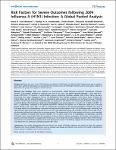Risk factors for severe outcomes following 2009 influenza A (H1N1) infection: a global pooled analysis.
Kerkhove, Maria D. van
Vandemaele, Katelijn A. H.
Shinde, Vivek
Jaramillo-Gutierrez, Giovanna
Koukounari, Artemis
Donnelly, Christl A.
Carlino, Luis O.
Owen, Rhonda
Paterson, Beverly
Pelletier, Louise
Vachon, Julie
Gonzalez, Claudia
Hongjie, Yu
Zijian, Feng
Chuang, Shuk Kwan
Au, Albert
Buda, Silke
Krause, Gérard
Haas, Walter
Background: Since the start of the 2009 influenza A pandemic (H1N1pdm), the World Health Organization and its member states have gathered information to characterize the clinical severity of H1N1pdm infection and to assist policy makers to determine risk groups for targeted control measures. Methods and Findings: Data were collected on approximately 70,000 laboratory-confirmed hospitalized H1N1pdm patients, 9,700 patients admitted to intensive care units (ICUs), and 2,500 deaths reported between 1 April 2009 and 1 January 2010 from 19 countries or administrative regions—Argentina, Australia, Canada, Chile, China, France, Germany, Hong Kong SAR, Japan, Madagascar, Mexico, the Netherlands, New Zealand, Singapore, South Africa, Spain, Thailand, the United States, and the United Kingdom—to characterize and compare the distribution of risk factors among H1N1pdm patients at three levels of severity: hospitalizations, ICU admissions, and deaths. The median age of patients increased with severity of disease. The highest per capita risk of hospitalization was among patients ,5 y and 5–14 y (relative risk [RR] = 3.3 and 3.2, respectively, compared to the general population), whereas the highest risk of death per capita was in the age groups 50–64 y and $65 y (RR = 1.5 and 1.6, respectively, compared to the general population). Similarly, the ratio of H1N1pdm deaths to hospitalizations increased with age and was the highest in the $65-y-old age group, indicating that while infection rates have been observed to be very low in the oldest age group, risk of death in those over the age of 64 y who became infected was higher than in younger groups. The proportion of H1N1pdm patients with one or more reported chronic conditions increased with severity (median = 31.1%, 52.3%, and 61.8% of hospitalized, ICU-admitted, and fatal H1N1pdm cases, respectively). With the exception of the risk factors asthma, pregnancy, and obesity, the proportion of patients with each risk factor increased with severity level. For all levels of severity, pregnant women in their third trimester consistently accounted for the majority of the total of pregnant women. Our findings suggest that morbid obesity might be a risk factor for ICU admission and fatal outcome (RR = 36.3). Conclusions: Our results demonstrate that risk factors for severe H1N1pdm infection are similar to those for seasonal influenza, with some notable differences, such as younger age groups and obesity, and reinforce the need to identify and protect groups at highest risk of severe outcomes.
No license information
Related Items
Show related Items with similar Title, Author, Creator or Subject.
-
2016-02-18ZeitschriftenartikelVaccine effectiveness in preventing laboratory-confirmed influenza in primary care patients in a season of co-circulation of influenza A(H1N1)pdm09, B and drifted A(H3N2), I-MOVE Multicentre Case–Control Study, Europe 2014/15 Valenciano, Marta; Kissling, Esther; Reuss, Annicka; Rizzo, C.; Gherasim, A.; Horváth, Judit K.; Domegan, L.; Pitigoi, Daniela; Machado, Ausenda; Bella, A.; Paradowska-Stankiewicz, I.; Larrauri, A.; Ferenczi, A.; O´Donell, Joan; Lazar, M.; Pechirra, P.; Korczyńska, M. R.; Pozo, Francisco; Moren, A.Influenza A(H3N2), A(H1N1)pdm09 and B viruses co-circulated in Europe in 2014/15. We undertook a multicentre case–control study in eight European countries to measure 2014/15 influenza vaccine effectiveness (VE) against ...
-
2016-10-13ZeitschriftenartikelImproving influenza virological surveillance in Europe: strain-based reporting of antigenic and genetic characterisation data, 11 European countries, influenza season 2013/14 Broberg, E.; Hungnes, Olav; Schweiger, Brunhilde; Prosenc, Katarina; Daniels, R.; Guiomar, R.; Ikonen, N.; Kossyvakis, A.; Pozo, Francisco; Puzelli, S.; Thomas, I.; Waters, A.; Wiman, Å.; Meijer, AdamInfluenza antigenic and genetic characterisation data are crucial for influenza vaccine composition decision making. Previously, aggregate data were reported to the European Centre for Disease Prevention and Control by ...
-
2013-02-14ZeitschriftenartikelEarly estimates of seasonal influenza vaccine effectiveness in Europe: results from the i-move multicentre case–control study, 2012/13 Valenciano, M.; Kissling, E.We conducted a test-negative case–control study based in five European sentinel surveillance networks. The early 2012/13 adjusted influenza vaccine effectiveness was 78.2% (95% CI: 18.0 to 94.2) against influenza B, 62.1% ...

